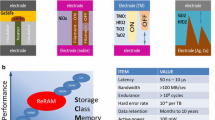Abstract
The authors investigate the conduction filament (CF) properties of a Cu–\(\textit{HfO}_{2}\) based conductive bridging resistive memory device by implementing a numerical simulation of the low and high resistive states, starting from a random initial distribution of oxygen vacancies (OV) defects states in the resistive switching layer (RSL) to a formed CF and ending in a ruptured state. A calculation approach which accounts for both the statistical nature of the system and the synergetic effect of OV and Cu species on the overall conductance is presented. By defining a disorder parameter, the correlation between the OV initial distribution and the CF reset behavior is analyzed. A dependence of the reset transition, being either abrupt or progressive, on the physical shape of the CF which in turn is affected by this disorder is shown to exist based on the simulation results.










Similar content being viewed by others

References
Tseng, T.Y., Sze, S.M.: An introduction to nonvolatile memories. In: Tseng, T.Y., Sze, S.M. (eds.) Nonvolatile Memories: Materials, Devices, and Applications, pp. 1–9. American Scientific Publishers, Valencia (2012)
Wong, H.-S.P., Lee, H.Y., Yu, S., Chen, Y.S., Wu, Y., Chen, P.S., Lee, B., Chen, F.T., Tsai, M.J.: Metal-oxide RRAM. Proc. IEEE 100(6), 1951–1970 (2012). doi:10.1109/JPROC.2012.2190369
Yu, S., Guan, X., Wong, H.S.P.: On the stochastic nature of resistive switching in metal oxide RRAM: physical modeling, monte carlo simulation, and experimental characterization. In: IEDM, pp. 17.3.1–17.3.4. (2011). doi:10.1109/IEDM.2011.6131572
Waser, R., Aono, M.: Nanoionics-based resistive switching memories. Nat. Mater. 6, 833–840 (2007). doi:10.1038/nmat2023
Russo, U., Kamalanathan, D., Ielmini, D., Lacaita, A.L., Kozicki, M.N.: Study of multilevel programming in programmable metallization cell (PMC) memory. IEEE Trans. Electron Devices 56(5), 1040–1047 (2009)
Landau, D.P., Binder, K.: A Guide to Monte Carlo Simulations in Statistical Physics. Cambridge University Press, Cambridge (2000)
Berco, D., Tseng, T.Y.: A comprehensive study of bipolar operation in resistive switching memory devices. J. Comput. Electron. (2015). doi:10.1007/s10825-015-0736-7
Celano, U., et al.: Progressive vs. abrupt reset behavior in conductive bridging devices: a C-AFM tomography study. In: IEDM, pp. 14.1.1–14.1.4. (2014). doi:10.1109/IEDM.2014.7047048
Molas, G., et al.: Controlling oxygen vacancies in doped oxide based CBRAM for improved memory performances. In: IEDM, pp. 6.1.1–6.1.4. (2014). doi:10.1109/IEDM.2014.7046993
Milosevic, N.D., Maglic, K.D.: Thermophysical properties of solid phase hafnium at high temperatures. Int. J. Thermophys. 27(2), 530–553 (2006)
Larentis, S., Nardi, F., Balatti, S., Gilmer, D.C., Ielmini, D.: Resistive switching by voltage-driven ion migration in bipolar RRAM–part II: modeling. IEEE Trans. Electron Devices 59(9), 2468–2475 (2012). doi:10.1109/TED.2012.2202320
Banno, N., Sakamoto, T., Iguchi, N., Sunamura, H., Terabe, K., Hasegawa, T., Aono, M.: Diffusivity of Cu ions in solid electrolyte and its effect on the performance of nanometer-scale switch. IEEE Trans. Electron Devices 55(11), 3283–3287 (2008). doi:10.1109/TED.2008.2004246
Wang, Y., et al.: Investigation of resistive switching in Cu-doped HfO2 thin film for multilevel non-volatile memory applications. Nanotechnology 21(4), 045202 (2010). doi:10.1088/0957-4484/21/4/045202
Lu, J.L., et al.: Optimal migration route of Cu in HfO2. J. Semiconductors 35(1), 013001 (2014)
Ielmini, D.: Modeling the universal set/reset characteristics of bipolar RRAM by field- and temperature-driven filament growth. IEEE Trans. Electron Devices 58(12), 4309–4317 (2011). doi:10.1109/TED.2011.2167513
Guan, X., Yu, S., Wong, H.-S.P.: On the switching parameter variation of metal oxide RRAM—part I: physical modeling and simulation methodology. IEEE Trans. Electron Devices 59(4), 1172–1182 (2012)
Huang, P., Liu, X.Y., Chen, B., Li, H.T., Wang, Y.J., Deng, Y.X., Wei, K.L., Zeng, L., Gao, B., Du, G., Zhang, X., Kang, J.F.: A physics-based compact model of metal-oxide-based RRAM DC and AC operations. IEEE Trans. Electron Devices 60(12), 4090–4097 (2013). doi:10.1109/TED.2013.2287755
Guy, J., et al.: Experimental and theoretical understanding of forming, SET and RESET operations in conductive bridge RAM (CBRAM) for memory stack optimization. In: IEDM, pp. 6.5.1-6.5.4. (2014). doi:10.1109/IEDM.2014.7046997
Zheng, J.X., Ceder, G., Maxisch, T., Chim, W.K., Choi, W.K.: First-principles study of native point defects in hafnia and zirconia. Phys. Rev. B 75, 104112 (2007). doi:10.1103/PhysRevB.75.104112
Reed, T.B.: Free Energy of Formation of Binary Compounds. MIT Press, Cambridge (1971)
Acknowledgments
This work is supported by National Science Council, Taiwan, under Project No. NSC 102-2221-E-009-134-MY3.
Author information
Authors and Affiliations
Corresponding author
Rights and permissions
About this article
Cite this article
Berco, D., Tseng, TY. A numerical analysis of progressive and abrupt reset in conductive bridging RRAM. J Comput Electron 15, 586–594 (2016). https://doi.org/10.1007/s10825-015-0744-7
Published:
Issue Date:
DOI: https://doi.org/10.1007/s10825-015-0744-7



